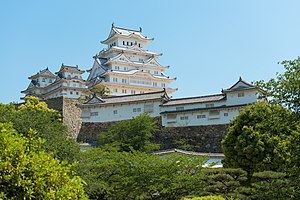Himeji Castle
| Himeji-jō | ||
|---|---|---|
|
Himeji Castle in May 2015 after five years of renovation of the roofs and walls |
||
| Alternative name (s): | Shirasagijō | |
| Creation time : | 1346 | |
| Castle type : | Hirayamajiro ( hill castle ) | |
| Conservation status: | Receive | |
| Construction: | Stone, wood | |
| Place: | Himeji | |
| Geographical location | 34 ° 50 '21.8 " N , 134 ° 41' 38.3" E | |
|
|
||
The Himeji Castle ( Japanese 姫 路 城 , Himeji-jō ) is located in the city of Himeji in the Japanese prefecture of Hyōgo .
It is one of the oldest surviving structures from 17th century Japan. The castle complex , which consists of 83 individual buildings, is considered the most beautiful example of Japanese castle construction and has the nickname Shirasagijō ( 白鷺 城 , German "White Heron Castle"), an allusion to its white outer walls and roofs. Despite their architectural beauty, such as B. its spiral-shaped ground plan, its fortifications ( nawabari ) are highly developed, so that the castle was considered practically impregnable.
Himeji Castle is one of the national cultural treasures of Japan , was declared a Special Historic Site ( tokubetsu shiseki ) in 1956 and recognized as a World Heritage Site by UNESCO in 1993 .
The roofs and walls of the castle were renovated from April 2010 to March 2015, whereby the roofs, which were darkened by pollution, were restored to their original white condition.
history
The castle's first buildings were built at the beginning of the Muromachi period in 1346. The architect is Akamatsu Sadanori , who had previously built the Shomyoji Temple at the foot of the Himeji Mountain, in the place of which the castle complex was now built.
The largest expansion, which is often referred to as the actual start of Himeji-jō's construction, took place in 1580, when Toyotomi Hideyoshi took over the castle and had three-story castle towers built.
After the Battle of Sekigahara , the castle fell to Tokugawa Ieyasu , who shortly afterwards left it to Ikeda Terumasa . This extended the system within an eight-year construction period from 1601 to 1609 with typical elements from the Momoyama period to its present form. He also built the five-story main building ( 天 守 閣 , tenshukaku ). The last major expansion of the castle is dated to 1618.
The actual residence was demolished after 1868, but the fortifications around the impressive tenshukaku - but never intended for living - have been preserved.
Ikeda was followed by:
- Honda (1617-1639)
- Okudaira (1639-1648)
- Matsudaira (1648-1649)
- Sakakibara (1648–1667)
- Matsudaira (1667-1684)
- Sakakibara (1684–1704)
- Honda (1704-1741)
- Matsudaira (1741-1749)
- Sakai (1749–1868) with an income of 155,000 koku .
At the end of the Second World War , Himeji-jō was bombed, but survived this almost undamaged.
Himeji-jō has served as a film set for internationally known productions several times: In the film James Bond 007 - You Only Live Twice (1967) it was shown as the headquarters of the Japanese secret police, in 1980 the castle was used in the eponymous film based on James Clavell's novel Shogun Television series to replace Osaka Castle . A considerable part of the film Ran (1985) by Japanese director Akira Kurosawa is set there, and scenes from the samurai epic Last Samurai (2003) were also filmed there.
See also
Individual evidence
- ↑ UNESCO World Heritage Center: Himeji-jo. Retrieved September 6, 2017 .
- ↑ The plan of the construction work and its current status ( Memento from July 3, 2016 in the Internet Archive )
- ^ E. Papinot: Historical and Geographical Dictionary of Japan. 1910. (Reprint: Tuttle, 1972, ISBN 0-8048-0996-8 )
literature
- Oleg Benesch and Ran Zwigenberg: Japan's Castles: Citadels of Modernity in War and Peace. Cambridge, 2019, ISBN 9781108481946 .
Web links
- Official website
- Internet presence of the castle ( memento of October 17, 2013 in the Internet Archive ) (English) - Flash
- Entry on the UNESCO World Heritage Center website ( English and French ).





